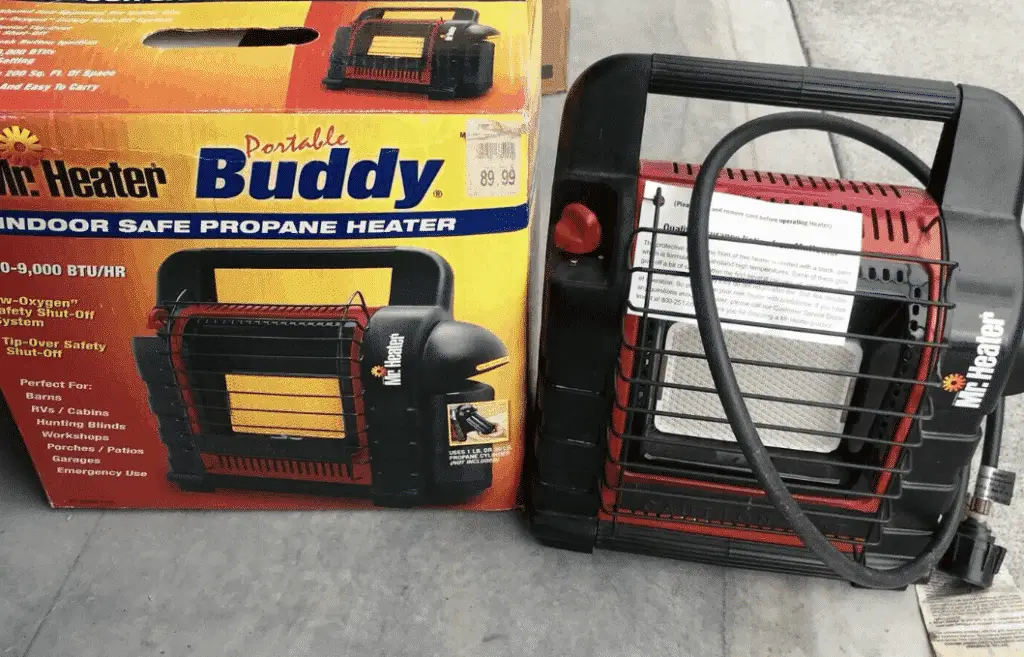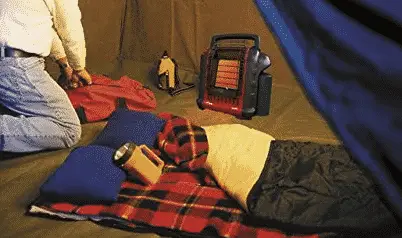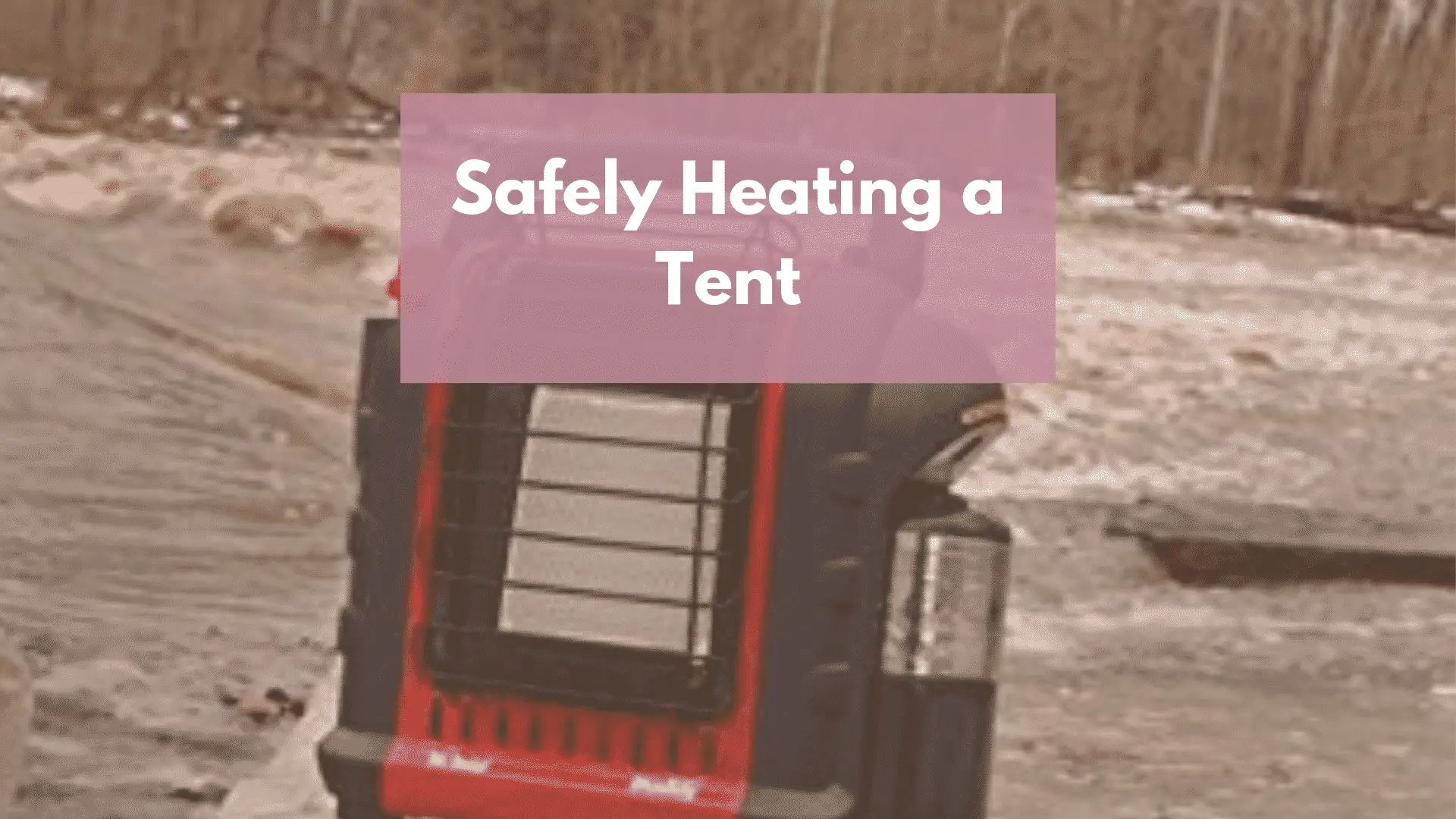Winter is coming, but that doesn’t mean you need to stop camping. While it might not be the same as summer camping, with the right gear winter camping can be downright comfortable. It all boils down to layering and finding ways to heat up your tent.
How Do You Heat A Tent In Cold Weather? There are 2 main ways to heat up your tent in the winter. External heat sources can be used while awake, and the sleeping bag will keep you warm at night. It’s less about heating the tent than maintaining warmth.
Don’t get me wrong, I’m not recommending waiting for the next blizzard and heading out into the wilderness. Some days your better off staying at home, but there are ways to extend your camping season.
Zero degree sleeping bags, insulated pads and winter tents will all help keep you warm, but some days you’ll need a little more oomph to keep you comfortable. Here are a few of my favorite ways to warm up a tent.
Table Of Contents
How to Heat A Tent In Cold Weather

External heat sources all come with a certain degree of danger. However, when the proper precautions are taken they can be used safely.
Start off by working on improving your sleep system than worry about heaters. A quality sleeping bag/pad is all you need to get through the night. With that being said, heaters will help get the chill out of the air. Just don’t expect heat to stay inside thin tent walls.
- Electric Heaters: If you’re camping in a RV site and have access to electric just about any home electric heater will work. Just make sure it has a thermostat cause your tent will get hot. Electric heaters are much safer than propane, but obviously they need an electric hookup.
- Propane Heaters: When it’s seriously cold propane heaters are the way to go. (This is My Favorite) You don’t have to worry about electric hookups and it runs for hours. It will automatically shut off when tipped over and is carbon monoxide safe.
- Candle Lanterns: Candle lanterns (like this one) are mainly used for light, but they will actually increase the surrounding temperature 10-15 degrees. You can also heat small amounts of food and water on the heat shield above.
- Wood Burning Heaters (Tents With Exhaust Ports): You can only use a wood burning stove in canvas tents that have exhaust ports. If there’s no way to vent the exhaust you will end up with carbon monoxide poisoning.
- Battery Powered Heaters (extremely expensive): Heaters require a crazy amount of power to run so you will need to spend a small fortune on a portable power station. Here’s an example: pairing a Jackery 1500 (1534 watt capacity) with a Honeywell Cubicle Heater (100 watt/low, 250 watt/high) will get you 6-15 hours of heat. Cheaper power stations won’t have the capacity to run your heater for long.
- Cold Weather Sleeping Gear: Cold weather gear is obviously your first defense against the cold. A zero degree sleeping bag paired with a pad will get you through even the coldest nights.
Focus on Your Sleep System Before Heating Your Tent
Heaters should only be used to supplement your sleeping bag and pad. Buy a sleeping bag with a temperature rating 15 degrees lower than the expected night time temperature and high R-Value Sleeping Pad
Sleeping bag liners will add additional versatility to your bag. My Sea to Summit Reactor Liner adds 25 degrees of warmth to my sleeping bags temperature rating. High R-Value sleeping pads will put an extra layer between your body and the cold hard ground.
Once you have your sleep system down you will only need to use the heater while you’re hanging out. Tents are terrible at trapping heat so you will end up burning through lots of fuel if you don’t have access to electricity. Try to use the heater sparingly if you’re limited on fuel.
How To Heat A Tent Without Electricity
Most people won’t have access to electricity while camping in cold weather. That means you will need to heat your tent with either a propane heater or candle lantern. Candle lanterns are more for light than heat, but they will increase the temperature in your tent by 10°-15° Fahrenheit.
Propane Heaters Are The Best Way To Heat Your Tent
Propane heaters are by far the best option when cold weather camping. The only downside is propane heaters will always emit trace amounts of carbon monoxide. Most of the time this won’t be a problem since tents aren’t air tight, but it is worth taking note.
Remember that 4-Season tents designed to seal out storms will trap carbon monoxide. You really shouldn’t need a heater in a 4-season tent. Stick to a 3-Season tent if you’re going to use a propane heater.
Personally I’m a huge fan of the Mr. Heater brand of camping heaters.(this is the one I use) There are a few different sizes, but I prefer the smaller buddy. It’s the same heater I use in my ice fishing rig.
Main Advantages:
- Keep You Warmer: Propane Heaters are going to keep you warmer than any other style of tent heater. Camping heaters will typically heat over 225 square feet of tent space(that’s a big tent).
- Safe and Efficient: All camping heaters are designed with built in safety features. Most of them are going to be tip proof and have the heating element enclosed in a steel cage. They should also have a built in carbon-monoxide detector and auto-shutoff.
- Lightweight and Portable: You probably won’t be bringing a heater along on a winter backpacking trip, but they’re perfect for primitive campsites. They’re designed with transportation in mind with lightweight bodies and built in handles.
Is it Safe to Use a Propane Heater in a Tent?

Throughout the past 20 years I’ve been using a propane heater in my tent. At first I was wary, but throughout the years they’ve proven perfectly safe There are a few things you need to keep in mind when buying a propane heater.
- Enclosed Heat Source: Only buy propane heaters that have an enclosed heat source. The Mr Heater pictured above has its heat source enclosed in a metal cage. You could catch something on fire if you aren’t careful, but it’s highly unlikely.
- Tip Protection: Find a heater that automatically shuts off when it tips over.
- Burns Without Carbon Monoxide: Most of the modern propane tent heaters use a catalytic technology that limits carbon monoxide. Since carbon monoxide is tasteless, odorless and deadly this is a must have feature in a unventilated place.
Propane tent heaters are relatively safe! Having said that there are a few dangers that you need to keep in mind. Obviously these heaters are going to produce heat so keep them away from the rest of your gear.
You don’t want to accidentally toss a jacket on top of the unit. It’s not an open flame so it won’t automatically ignite, but it will slowly melt and eventually catch fire. It really all boils down to common sense.
You’ll also need some ventilation since you’re burning propane. All you really need is a small screened in window zipped open near the heater.
Look For Catalytic Heaters
Most camping heaters are catalytic, which basically means they heat without a flame. Catalytic heaters don’t produce much carbon monoxide, and they shouldn’t ignite gear that happens to bump into them.
Shut-Off The Heater Before Bed
Some people leave their propane heaters burning while they sleep, but that’s a bad idea. I twist and turn in my sleep and I can just imagine burning a big old hole in my sleeping bag. Plus if there’s a ventilation issue you’d never be able to recognize the signs of carbon monoxide.
Instead of sleeping with the heater on I like to turn it on 1 hour before bed. Crank up the heat until the tent is hotter than you actually need. It’s more about getting the tent comfortable and warming up the sleeping bag.
Your sleeping bag should be doing the heavy lifting throughout the night. A high quality sleeping bag will keep you warm until morning. Check out my post on dressing in layers in your sleeping bag.
If it gets unbearably cold in a couple hours, kick on the heater for 5-10 minutes and you should be good to go.
Proper Ventilation
Even though modern camping heaters are designed to reduce the risks of carbon monoxide poisoning it’s always a good idea to ventilate your tent. Even on the coldest night cracking a window isn’t going to stop your heater from heating the tent. You can also open up the door in your vestibule and set the heater nearby.
Recognizing Signs of Carbon Monoxide Poisoning
It doesn’t matter how careful you are when you work with propane there’s always a risk of carbon monoxide poisoning. Since carbon monoxide is a tasteless odorless gas it’s difficult to recognize the signs.
Main symptoms
- Dull Headache That Doesn’t Go Away
- Muscle Weakness
- Dizzyness, Nausea and Vomiting
- Confusion and Shortness of Breath
- Blurred Vision
- Loss of Consciousness
Carbon Monoxide poisoning is extremely dangerous especially for people who are sleeping or intoxicated. Never sleep with a propane heater in your tent and if you notice signs of carbon monoxide shut off the heater, ventilate your tent thoroughly and go outside.
Other Tips to Stay Warm in Your Tent
- Winter Sleeping Bag: If you’re going camping in the winter you can’t just use any old sleeping bag. When camping in the United States and Southern Canada you can typically get away with a zero degree sleeping bag.
- Use a Sleeping Bag Liner: Sleeping bag liners are going to protect your bag from dirt and make it much warmer. I actually use this sleeping bag liner in place of my bag during the summer and then inside my bag in the winter. It adds about 25 degrees of warmth to my bag so I don’t have to worry about being cold.
- Sleeping Pads Increase Insulation: Sleeping pads are going to increase the insulation between your body and the cold ground. Even a cheap foam sleeping pad (like this one) will make a major difference throughout the night.
- Dress in Layers: Some people like to sleep naked in a sleeping bag, but during the winter you should dress in layers. Check out my post on layering clothes in a sleeping bag for more info.
- Stay Dry: Dampness is a recipe for a cold night. Even on snowy days you need to work to keep all your wet gear outside and keep your tent ventilated.



